Tesla's Bond Rating Analysis: Justification of Moody's and S&P Views
VerifiedAdded on 2023/06/07
|5
|1175
|344
Case Study
AI Summary
This case study provides an in-depth analysis of Tesla's bond rating, examining the perspectives of Moody's and S&P. It delves into the financial risks and debt associated with Tesla, particularly focusing on the production challenges of Model 3 and the company's liquidity concerns. The analysis considers factors such as production delays, cash flow shortages, and upcoming bond maturities, ultimately supporting a B- rating. The study also evaluates the potential impact of increased production and additional financing on Tesla's financial stability and bond rating, further providing calculations for bond face value, loss given default, and cumulative probability of default. The conclusion suggests that the rating could fluctuate based on production performance and the company's ability to secure financing.
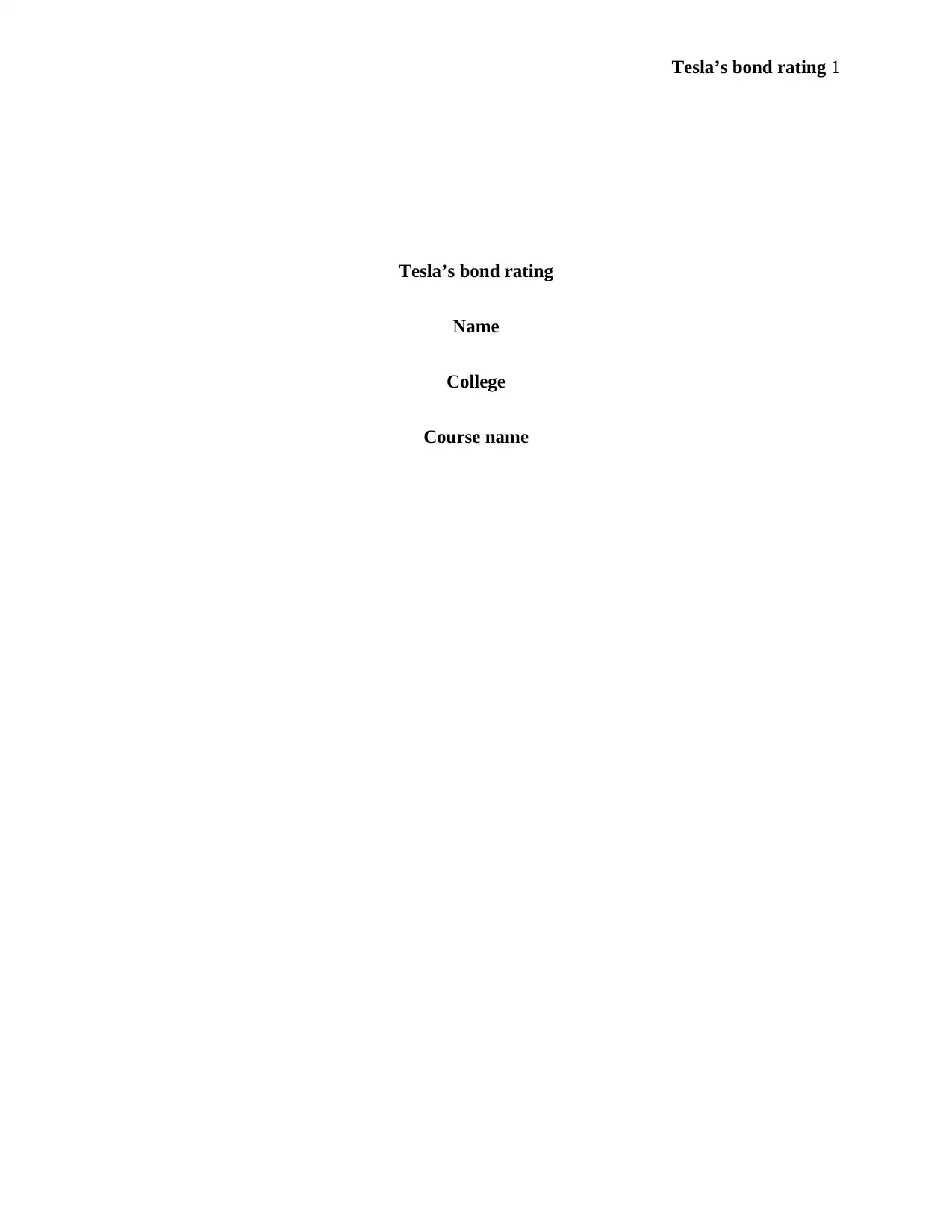
Tesla’s bond rating 1
Tesla’s bond rating
Name
College
Course name
Tesla’s bond rating
Name
College
Course name
Paraphrase This Document
Need a fresh take? Get an instant paraphrase of this document with our AI Paraphraser
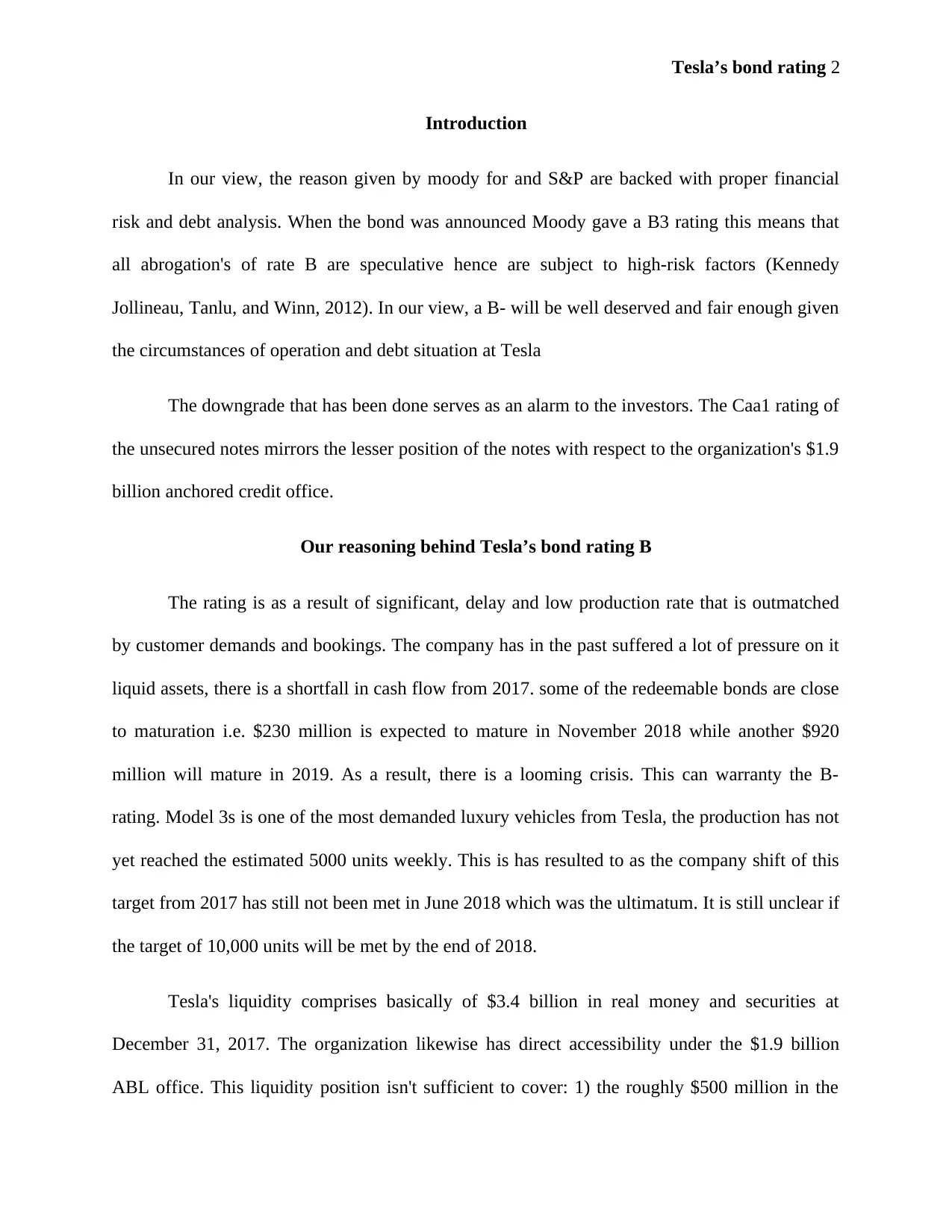
Tesla’s bond rating 2
Introduction
In our view, the reason given by moody for and S&P are backed with proper financial
risk and debt analysis. When the bond was announced Moody gave a B3 rating this means that
all abrogation's of rate B are speculative hence are subject to high-risk factors (Kennedy
Jollineau, Tanlu, and Winn, 2012). In our view, a B- will be well deserved and fair enough given
the circumstances of operation and debt situation at Tesla
The downgrade that has been done serves as an alarm to the investors. The Caa1 rating of
the unsecured notes mirrors the lesser position of the notes with respect to the organization's $1.9
billion anchored credit office.
Our reasoning behind Tesla’s bond rating B
The rating is as a result of significant, delay and low production rate that is outmatched
by customer demands and bookings. The company has in the past suffered a lot of pressure on it
liquid assets, there is a shortfall in cash flow from 2017. some of the redeemable bonds are close
to maturation i.e. $230 million is expected to mature in November 2018 while another $920
million will mature in 2019. As a result, there is a looming crisis. This can warranty the B-
rating. Model 3s is one of the most demanded luxury vehicles from Tesla, the production has not
yet reached the estimated 5000 units weekly. This is has resulted to as the company shift of this
target from 2017 has still not been met in June 2018 which was the ultimatum. It is still unclear if
the target of 10,000 units will be met by the end of 2018.
Tesla's liquidity comprises basically of $3.4 billion in real money and securities at
December 31, 2017. The organization likewise has direct accessibility under the $1.9 billion
ABL office. This liquidity position isn't sufficient to cover: 1) the roughly $500 million in the
Introduction
In our view, the reason given by moody for and S&P are backed with proper financial
risk and debt analysis. When the bond was announced Moody gave a B3 rating this means that
all abrogation's of rate B are speculative hence are subject to high-risk factors (Kennedy
Jollineau, Tanlu, and Winn, 2012). In our view, a B- will be well deserved and fair enough given
the circumstances of operation and debt situation at Tesla
The downgrade that has been done serves as an alarm to the investors. The Caa1 rating of
the unsecured notes mirrors the lesser position of the notes with respect to the organization's $1.9
billion anchored credit office.
Our reasoning behind Tesla’s bond rating B
The rating is as a result of significant, delay and low production rate that is outmatched
by customer demands and bookings. The company has in the past suffered a lot of pressure on it
liquid assets, there is a shortfall in cash flow from 2017. some of the redeemable bonds are close
to maturation i.e. $230 million is expected to mature in November 2018 while another $920
million will mature in 2019. As a result, there is a looming crisis. This can warranty the B-
rating. Model 3s is one of the most demanded luxury vehicles from Tesla, the production has not
yet reached the estimated 5000 units weekly. This is has resulted to as the company shift of this
target from 2017 has still not been met in June 2018 which was the ultimatum. It is still unclear if
the target of 10,000 units will be met by the end of 2018.
Tesla's liquidity comprises basically of $3.4 billion in real money and securities at
December 31, 2017. The organization likewise has direct accessibility under the $1.9 billion
ABL office. This liquidity position isn't sufficient to cover: 1) the roughly $500 million in the
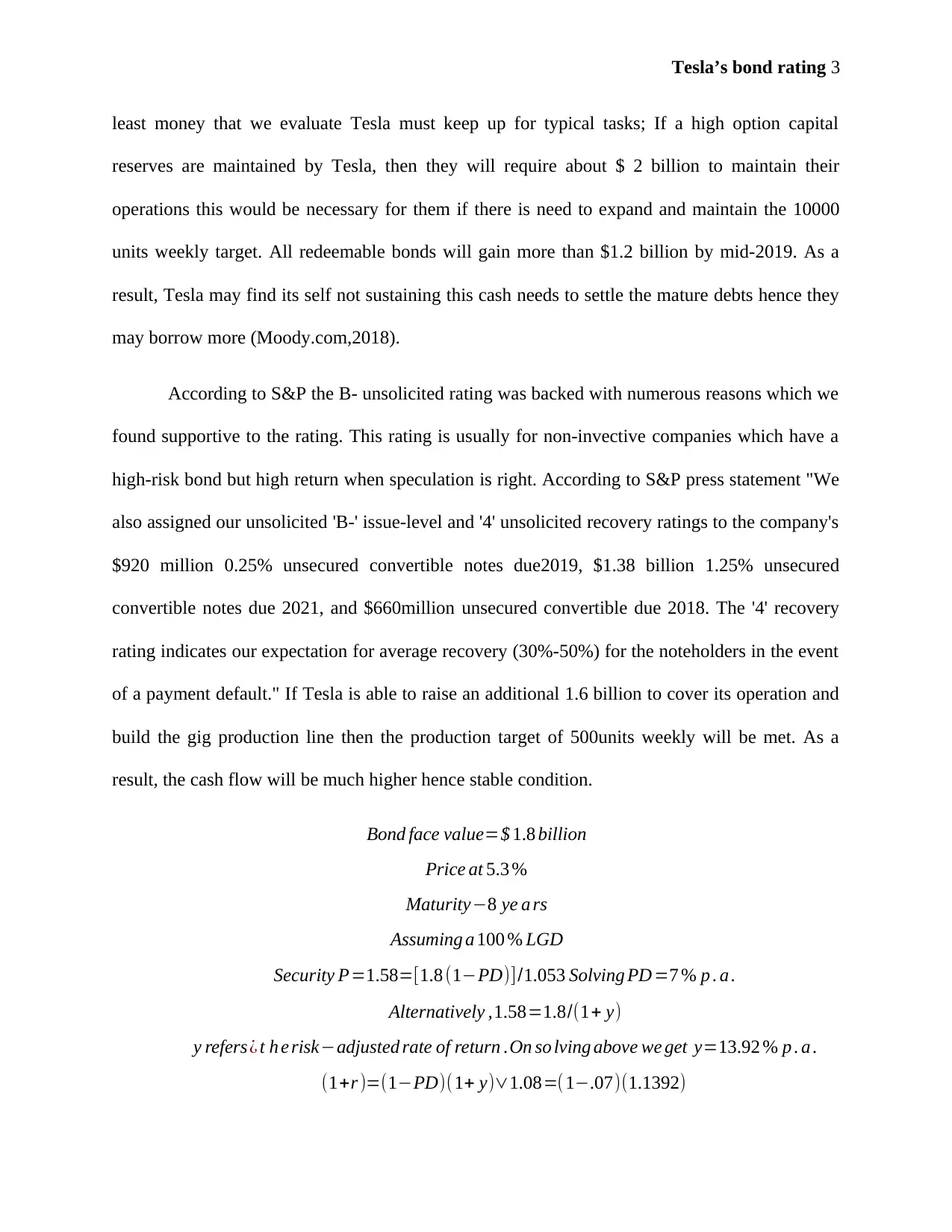
Tesla’s bond rating 3
least money that we evaluate Tesla must keep up for typical tasks; If a high option capital
reserves are maintained by Tesla, then they will require about $ 2 billion to maintain their
operations this would be necessary for them if there is need to expand and maintain the 10000
units weekly target. All redeemable bonds will gain more than $1.2 billion by mid-2019. As a
result, Tesla may find its self not sustaining this cash needs to settle the mature debts hence they
may borrow more (Moody.com,2018).
According to S&P the B- unsolicited rating was backed with numerous reasons which we
found supportive to the rating. This rating is usually for non-invective companies which have a
high-risk bond but high return when speculation is right. According to S&P press statement "We
also assigned our unsolicited 'B-' issue-level and '4' unsolicited recovery ratings to the company's
$920 million 0.25% unsecured convertible notes due2019, $1.38 billion 1.25% unsecured
convertible notes due 2021, and $660million unsecured convertible due 2018. The '4' recovery
rating indicates our expectation for average recovery (30%-50%) for the noteholders in the event
of a payment default." If Tesla is able to raise an additional 1.6 billion to cover its operation and
build the gig production line then the production target of 500units weekly will be met. As a
result, the cash flow will be much higher hence stable condition.
Bond face value=$ 1.8 billion
Price at 5.3 %
Maturity−8 ye a rs
Assuming a 100 % LGD
Security P=1.58=[1.8 (1−PD)]/1.053 Solving PD =7 % p . a .
Alternatively ,1.58=1.8/(1+ y)
y refers¿ t h e risk−adjusted rate of return .On so lving above we get y=13.92 % p . a .
(1+r )=(1−PD)(1+ y)∨1.08=(1−.07)(1.1392)
least money that we evaluate Tesla must keep up for typical tasks; If a high option capital
reserves are maintained by Tesla, then they will require about $ 2 billion to maintain their
operations this would be necessary for them if there is need to expand and maintain the 10000
units weekly target. All redeemable bonds will gain more than $1.2 billion by mid-2019. As a
result, Tesla may find its self not sustaining this cash needs to settle the mature debts hence they
may borrow more (Moody.com,2018).
According to S&P the B- unsolicited rating was backed with numerous reasons which we
found supportive to the rating. This rating is usually for non-invective companies which have a
high-risk bond but high return when speculation is right. According to S&P press statement "We
also assigned our unsolicited 'B-' issue-level and '4' unsolicited recovery ratings to the company's
$920 million 0.25% unsecured convertible notes due2019, $1.38 billion 1.25% unsecured
convertible notes due 2021, and $660million unsecured convertible due 2018. The '4' recovery
rating indicates our expectation for average recovery (30%-50%) for the noteholders in the event
of a payment default." If Tesla is able to raise an additional 1.6 billion to cover its operation and
build the gig production line then the production target of 500units weekly will be met. As a
result, the cash flow will be much higher hence stable condition.
Bond face value=$ 1.8 billion
Price at 5.3 %
Maturity−8 ye a rs
Assuming a 100 % LGD
Security P=1.58=[1.8 (1−PD)]/1.053 Solving PD =7 % p . a .
Alternatively ,1.58=1.8/(1+ y)
y refers¿ t h e risk−adjusted rate of return .On so lving above we get y=13.92 % p . a .
(1+r )=(1−PD)(1+ y)∨1.08=(1−.07)(1.1392)
⊘ This is a preview!⊘
Do you want full access?
Subscribe today to unlock all pages.

Trusted by 1+ million students worldwide
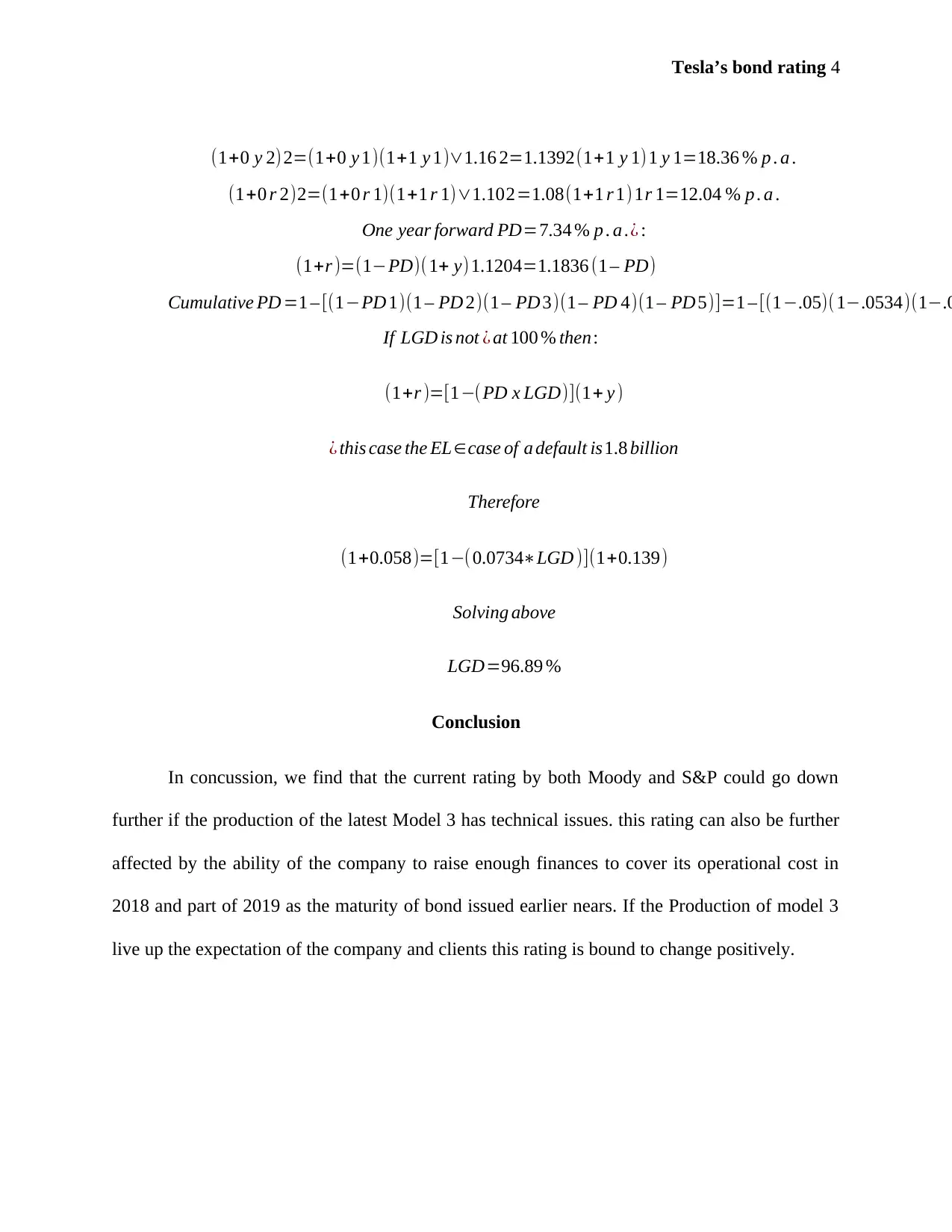
Tesla’s bond rating 4
(1+0 y 2) 2=(1+0 y 1)(1+1 y 1)∨1.16 2=1.1392(1+1 y 1)1 y 1=18.36 % p . a .
(1+0 r 2)2=(1+0 r 1)(1+1 r 1)∨1.102=1.08(1+1 r 1) 1r 1=12.04 % p . a .
One year forward PD=7.34 % p . a .¿ :
(1+r )=(1−PD)(1+ y)1.1204=1.1836 (1 – PD)
Cumulative PD =1 – [(1−PD 1)(1 – PD 2)(1 – PD 3)(1 – PD 4)(1 – PD 5)]=1 – [(1−.05)( 1−.0534)(1−.0
If LGD is not ¿ at 100 % then:
(1+r )=[1−( PD x LGD)](1+ y )
¿ this case the EL∈case of a default is1.8 billion
Therefore
(1+0.058)=[1−( 0.0734∗LGD )](1+0.139)
Solving above
LGD=96.89 %
Conclusion
In concussion, we find that the current rating by both Moody and S&P could go down
further if the production of the latest Model 3 has technical issues. this rating can also be further
affected by the ability of the company to raise enough finances to cover its operational cost in
2018 and part of 2019 as the maturity of bond issued earlier nears. If the Production of model 3
live up the expectation of the company and clients this rating is bound to change positively.
(1+0 y 2) 2=(1+0 y 1)(1+1 y 1)∨1.16 2=1.1392(1+1 y 1)1 y 1=18.36 % p . a .
(1+0 r 2)2=(1+0 r 1)(1+1 r 1)∨1.102=1.08(1+1 r 1) 1r 1=12.04 % p . a .
One year forward PD=7.34 % p . a .¿ :
(1+r )=(1−PD)(1+ y)1.1204=1.1836 (1 – PD)
Cumulative PD =1 – [(1−PD 1)(1 – PD 2)(1 – PD 3)(1 – PD 4)(1 – PD 5)]=1 – [(1−.05)( 1−.0534)(1−.0
If LGD is not ¿ at 100 % then:
(1+r )=[1−( PD x LGD)](1+ y )
¿ this case the EL∈case of a default is1.8 billion
Therefore
(1+0.058)=[1−( 0.0734∗LGD )](1+0.139)
Solving above
LGD=96.89 %
Conclusion
In concussion, we find that the current rating by both Moody and S&P could go down
further if the production of the latest Model 3 has technical issues. this rating can also be further
affected by the ability of the company to raise enough finances to cover its operational cost in
2018 and part of 2019 as the maturity of bond issued earlier nears. If the Production of model 3
live up the expectation of the company and clients this rating is bound to change positively.
Paraphrase This Document
Need a fresh take? Get an instant paraphrase of this document with our AI Paraphraser
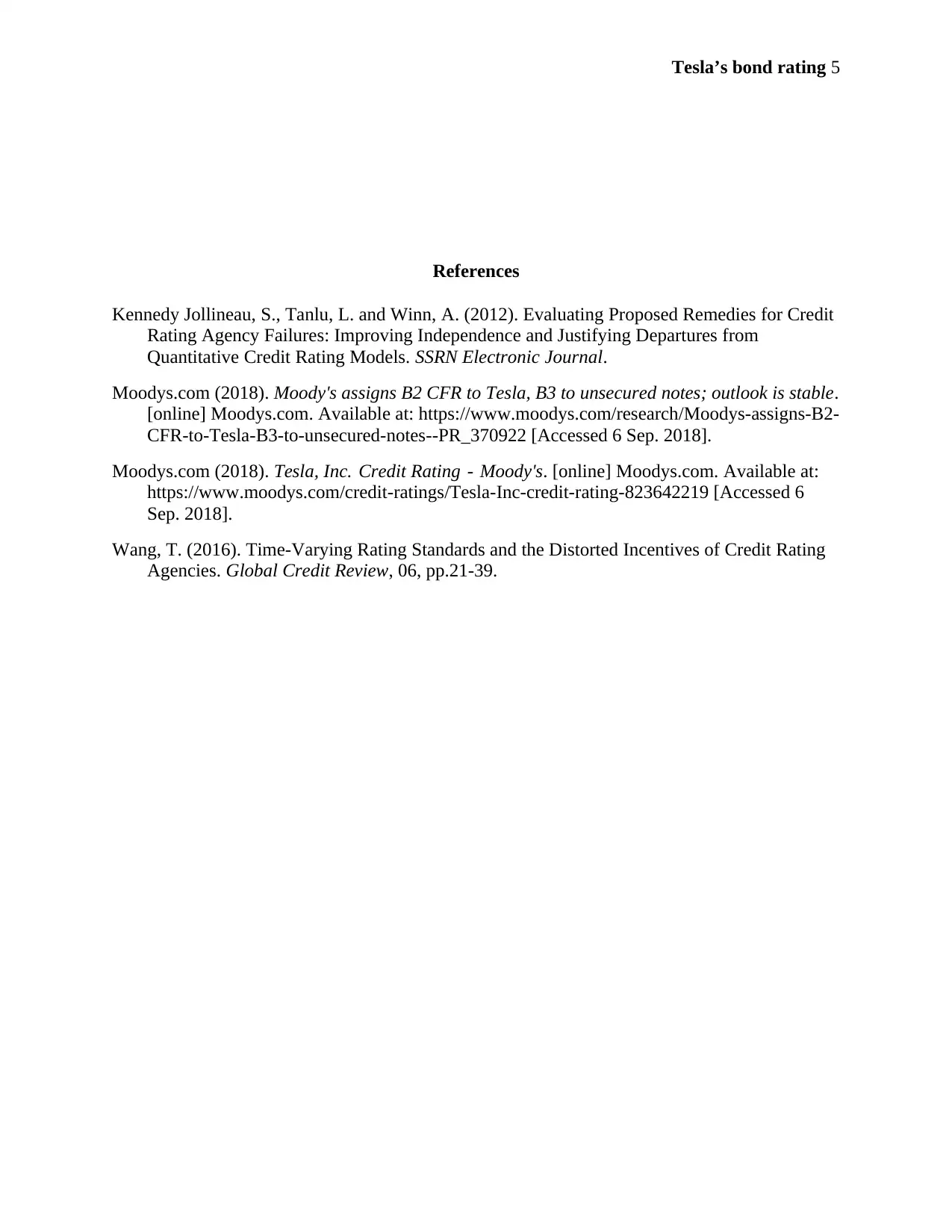
Tesla’s bond rating 5
References
Kennedy Jollineau, S., Tanlu, L. and Winn, A. (2012). Evaluating Proposed Remedies for Credit
Rating Agency Failures: Improving Independence and Justifying Departures from
Quantitative Credit Rating Models. SSRN Electronic Journal.
Moodys.com (2018). Moody's assigns B2 CFR to Tesla, B3 to unsecured notes; outlook is stable.
[online] Moodys.com. Available at: https://www.moodys.com/research/Moodys-assigns-B2-
CFR-to-Tesla-B3-to-unsecured-notes--PR_370922 [Accessed 6 Sep. 2018].
Moodys.com (2018). Tesla, Inc. Credit Rating - Moody's. [online] Moodys.com. Available at:
https://www.moodys.com/credit-ratings/Tesla-Inc-credit-rating-823642219 [Accessed 6
Sep. 2018].
Wang, T. (2016). Time-Varying Rating Standards and the Distorted Incentives of Credit Rating
Agencies. Global Credit Review, 06, pp.21-39.
References
Kennedy Jollineau, S., Tanlu, L. and Winn, A. (2012). Evaluating Proposed Remedies for Credit
Rating Agency Failures: Improving Independence and Justifying Departures from
Quantitative Credit Rating Models. SSRN Electronic Journal.
Moodys.com (2018). Moody's assigns B2 CFR to Tesla, B3 to unsecured notes; outlook is stable.
[online] Moodys.com. Available at: https://www.moodys.com/research/Moodys-assigns-B2-
CFR-to-Tesla-B3-to-unsecured-notes--PR_370922 [Accessed 6 Sep. 2018].
Moodys.com (2018). Tesla, Inc. Credit Rating - Moody's. [online] Moodys.com. Available at:
https://www.moodys.com/credit-ratings/Tesla-Inc-credit-rating-823642219 [Accessed 6
Sep. 2018].
Wang, T. (2016). Time-Varying Rating Standards and the Distorted Incentives of Credit Rating
Agencies. Global Credit Review, 06, pp.21-39.
1 out of 5
Your All-in-One AI-Powered Toolkit for Academic Success.
+13062052269
info@desklib.com
Available 24*7 on WhatsApp / Email
![[object Object]](/_next/static/media/star-bottom.7253800d.svg)
Unlock your academic potential
Copyright © 2020–2025 A2Z Services. All Rights Reserved. Developed and managed by ZUCOL.